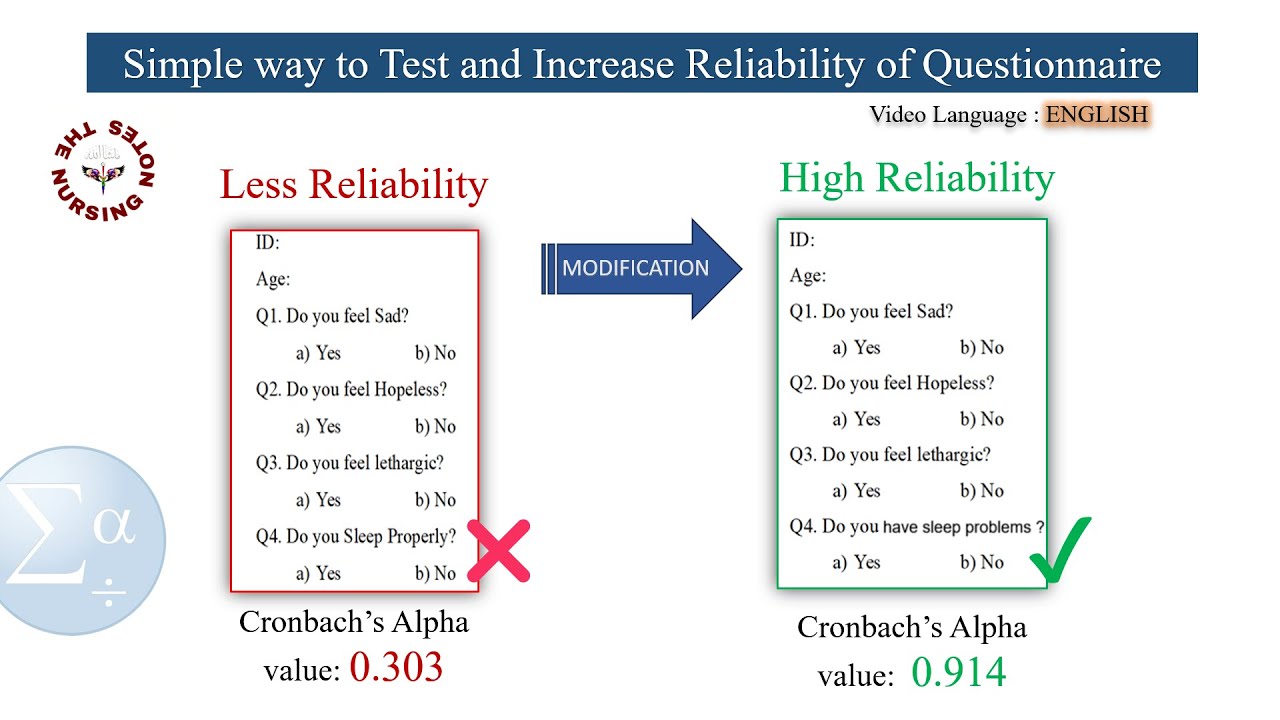Cronbach's Alpha (Simply explained)
TLDRThe video script introduces Chromebox Alpha, a statistical measure used to assess the internal consistency of a scale, which is a group of questions designed to measure a latent variable. It explains that a high internal consistency indicates that the items in the scale are highly correlated, making the scale reliable for measurement. The script provides an example of measuring extroversion through a questionnaire and demonstrates how to calculate Chromebox Alpha using statistical software. It also discusses how to interpret the results and the potential implications of removing items from the scale to improve its reliability. The video concludes by encouraging viewers to try the process themselves and look forward to future content.
Takeaways
- 🔍 Chromebox Alpha is used to measure the internal consistency of a scale, which is the extent to which a group of questions are related to each other.
- 📏 A scale is a set of questions (items) designed to measure a latent variable that cannot be directly measured.
- 🤝 High internal consistency means that the responses to the various items in a scale are highly correlated.
- 📉 A high Chromebox Alpha value does not necessarily indicate that the items are influenced by only one latent variable.
- 📋 To use Chromebox Alpha, all items must measure the same latent variable to ensure the reliability of the scale.
- 💡 The goal is for each individual question (item) in a scale to correlate as highly as possible with every other question.
- 📊 Chromebox Alpha gives an estimate of the measurement accuracy, or reliability, of a group of items.
- 📈 To calculate Chromebox Alpha, use statistical software or an online tool like datadept.net, which automates the process.
- 📝 Data for Chromebox Alpha calculation includes the number of items, average variance, and average inter-item covariance.
- 🚀 An Alpha value of 0.71 is considered just acceptable for internal consistency, based on the provided example.
- 🔧 Item scale statistics can show how the Alpha changes when one item is removed, potentially indicating which items to refine or remove for better consistency.
- 🎯 It's suggested to try calculating Chromebox Alpha yourself using available tools for a hands-on understanding of the process.
Q & A
What is the primary purpose of using Cronbach's Alpha?
-Cronbach's Alpha is used to measure the internal consistency of a scale, which is the extent to which a group of questions or items are related to each other, providing an estimate of the measurement accuracy or reliability of the items.
What is a latent variable in the context of the given transcript?
-A latent variable is a variable that cannot be measured directly, and to make it measurable, a scale consisting of a group of questions or items is used.
What does high internal consistency imply about the items in a scale?
-High internal consistency implies that the answers to the various items in the scale are highly correlated, meaning each individual question correlates as highly as possible with every other question in the scale.
Does a high Cronbach's Alpha value indicate that the items are influenced by only one latent variable?
-No, a high Cronbach's Alpha value does not provide evidence that the items are influenced by only one latent variable. It only indicates the level of internal consistency among the items.
What is the minimum condition required for using Cronbach's Alpha to estimate the reliability of a scale?
-The minimum condition required is that all questions or items in the scale must measure the same latent variable.
How can one measure extroversion according to the transcript?
-Extroversion can be measured using a scale from the Big Five personality traits, where respondents indicate how strongly certain characteristics, such as being outgoing, talkative, sociable, and enjoying social situations, apply to them.
What is the formula for calculating Cronbach's Alpha?
-Cronbach's Alpha can be calculated using the formula: α = N / (N - 1) * (1 - (Σ Variances - Σ Covariances) / Σ Variances), where N is the number of items, and the summations are over the variances and covariances of the items.
How can one calculate Cronbach's Alpha using statistical software?
-One can calculate Cronbach's Alpha using statistical software by inputting the data into the software, selecting the items for which the alpha is to be calculated, and then the software will automatically compute the value.
What does the Item-Scale Statistics table show?
-The Item-Scale Statistics table shows how the Cronbach's Alpha changes when one of the items is removed from the scale, which can help in determining the contribution of each item to the scale's reliability.
What does a Cronbach's Alpha value of 0.71 indicate about the scale's reliability?
-A Cronbach's Alpha value of 0.71 is considered just acceptable, suggesting that the scale has an adequate level of internal consistency for the items to be considered as measuring the same latent variable.
How can one interpret the changes in Cronbach's Alpha when items are removed?
-If the removal of an item results in an increase in Cronbach's Alpha, it suggests that the item may not be contributing positively to the scale's reliability. Conversely, if the Alpha decreases, it indicates that the item is contributing to the scale's internal consistency.
What is the significance of removing an item that increases the Cronbach's Alpha value?
-The significance of removing an item that increases the Cronbach's Alpha value is that it may indicate that the item is not measuring the same latent variable as the others, or it could be considered for removal to improve the scale's overall reliability.
Outlines
📊 Understanding Cronbach's Alpha for Internal Consistency
This paragraph explains the concept of Cronbach's Alpha, which is a measure of internal consistency for a set of items or questions that are intended to measure a single latent variable. It discusses how a scale is used to make latent variables measurable and the importance of high internal consistency among items. The paragraph also clarifies that Cronbach's Alpha does not test the influence of latent variables on individual items. It provides an example of measuring extroversion and salary, and guides on how to calculate Cronbach's Alpha using statistical software, emphasizing the interpretation of results.
🔍 Interpreting Cronbach's Alpha Results and Item Impact
The second paragraph delves into the interpretation of Cronbach's Alpha results, using a hypothetical example where extroverted people are believed to earn higher salaries. It presents a table that shows how the Alpha value changes when individual items are removed from the scale, indicating the impact of each item on the overall reliability. The example demonstrates how to use a statistical tool to calculate and interpret Cronbach's Alpha, and suggests considerations for improving the scale by potentially removing items that decrease the Alpha value.
Mindmap
Keywords
💡Chromebox Alpha
💡Latent Variable
💡Scale
💡Items
💡Internal Consistency
💡Reliability
💡Datadept.net
💡Survey
💡Big Five Personality Traits
💡Questionnaire
💡Interpretation
💡Statistical Software
Highlights
Chromebox alpha is used to measure the internal consistency of a scale, which is essential for estimating the reliability of a group of items measuring a latent variable.
A scale is a group of questions used to measure a latent variable indirectly, with individual questions called items.
High internal consistency means that the responses to various items in a scale are highly correlated.
The goal is for each item in a scale to correlate as highly as possible with every other item.
Chromebox alpha does not test whether items are influenced by a single latent variable; it measures how well items measure the same latent variable.
To estimate scale reliability using chromebox alpha, all items must measure the same latent variable.
An example hypothesis is that extroverted people earn a higher salary than introverted people.
Extroversion can be measured using a scale from the Big Five personality traits.
Surveys can be created on datadept.net to collect responses for calculating chromebox alpha.
Statistical software is used to calculate chromebox alpha, rather than manual calculation.
Datadept.net provides an easy way to calculate and interpret chromebox alpha for a set of items.
A chromebox alpha value of 0.71 is considered just acceptable for internal consistency.
Item scale statistics can show how chromebox alpha changes when one item is removed from the scale.
Removing an item can sometimes increase the chromebox alpha, indicating potential improvements to the scale.
The example provided is a fictional scenario created for illustrative purposes.
The video encourages viewers to try calculating chromebox alpha themselves to understand the process.
The video concludes with an invitation to viewers to join for the next session.
Transcripts
Browse More Related Video

Cronbach's Alpha - Excel

Cronbach's alpha or Coefficient alpha in simple language - DU Professor

Calculating and Interpreting Cronbach's Alpha Using SPSS

Internal Consistency

Mastering to Increase Cronbach's alpha value | Reliability Test | Simple| using SPSS

What is Cronbach's Alpha? - Explained Simply (Part 2)
5.0 / 5 (0 votes)
Thanks for rating: